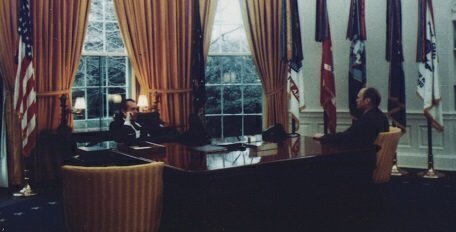On November 27, 1973, the United States Senate became the first legislative house to act under the 25th Amendment, when it voted to approve Representative Gerald Ford as the new Vice President. A week later, the House also approved Ford, making his appointment official.
 While it may seem obvious today that a new Vice President should be appointed to fill that office in case of a death, disability, resignation or impeachment, that wasn’t the case until 1967.
While it may seem obvious today that a new Vice President should be appointed to fill that office in case of a death, disability, resignation or impeachment, that wasn’t the case until 1967.
The 25th Amendment was ratified by the states on February 10, 1967 and it cleared up a lot of issues about presidential and vice-presidential succession that were unresolved (or unanticipated) by the Founding Fathers.
It was up to Vice President John Tyler, who found himself in an awkward position after President William Henry Harrison’s death in 1841, to set the precedent for presidential succession that lasted until 1967. In Article II, Section 1, the Constitution said that, “In Case of the Removal of the President from Office, or of his Death, Resignation, or Inability to discharge the Powers and Duties of the said Office, the Same shall devolve on the Vice President.”
After Harrison’s death, there was confusion about Tyler’s status as Acting President or as the actual President, in title as well as function. Tyler boldly declared himself as President for the remainder of Harrison’s term and Congress recognized his title. The precedent held after the deaths of six Presidents in office – Taylor, Lincoln, Garfield, McKinley, Harding and Franklin Roosevelt. But after President Dwight Eisenhower had health problems, a congressional effort started to clear up presidential succession questions. President John F. Kennedy’s assassination in November 1963 made the process imperative.
In the case of a vice-presidential vacancy before 1967, the office remained empty until the next general election. In fact, before 1967, the office of Vice President was vacant 16 times due to deaths, resignations and assumptions of the President’s office.
The 25th Amendment’s first use came in October 1973, when President Richard Nixon nominated Gerald Ford to replace Spiro Agnew just two days after Agnew’s resignation as Vice President.
Part of the push to get Ford approved was related to an expanded constitutional role granted to the Vice President under the 25th Amendment in cases where the President was unable to serve temporarily or permanently. The 25th Amendment made it very clear that the Vice President becomes President in the case of death, resignation and removal from office. It also said that a President can nominate someone to become Vice President if that office is vacant, with the approval of Congress.
Section 3 and 4 established new roles for the Vice President if the President were unable to perform his or her official duties. Certainly, one potential constitutional crisis would be the lack of a Vice President in office to start a Section 4 disability review of a President. Another is the lack of a constitutional or legal precedent for someone to act as a temporary Vice President, to start the Section 4 review process.
In October 1973, at least some of those options seemed in play as the Watergate Scandal was in full play and President Nixon’s future was in doubt.
Nixon considered four replacements for Agnew: Ford, Rockefeller, John Connolly and Ronald Reagan. Nixon preferred Connolly, but when his staff informally polled congressional Democrats, Ford was their choice.
In House and Senate hearings, the situation was tense as times since the Saturday Night Massacre happened during the Ford nomination process. But on November 27, the Democrat-controlled Senate voted 92 to 3 to confirm Ford, all but confirming his appointment. On December 6, the House agreed, in a 387 to 35 vote.
Ford then took his oath in the House chamber, leading Nixon aide Alexander Haig to comment on the seriousness of the occasion. "Ford was treated throughout the ceremony and afterwards as a President-in-waiting, especially by Republicans, and there can be little question that Richard Nixon's presidency was over, in their minds, from the moment his successor took the oath,” Haig said.
As a historical footnote, if the 25th Amendment had not been in place, House Speaker Carl Albert, a Democrat, would have replaced Nixon as acting President in August 1974.






